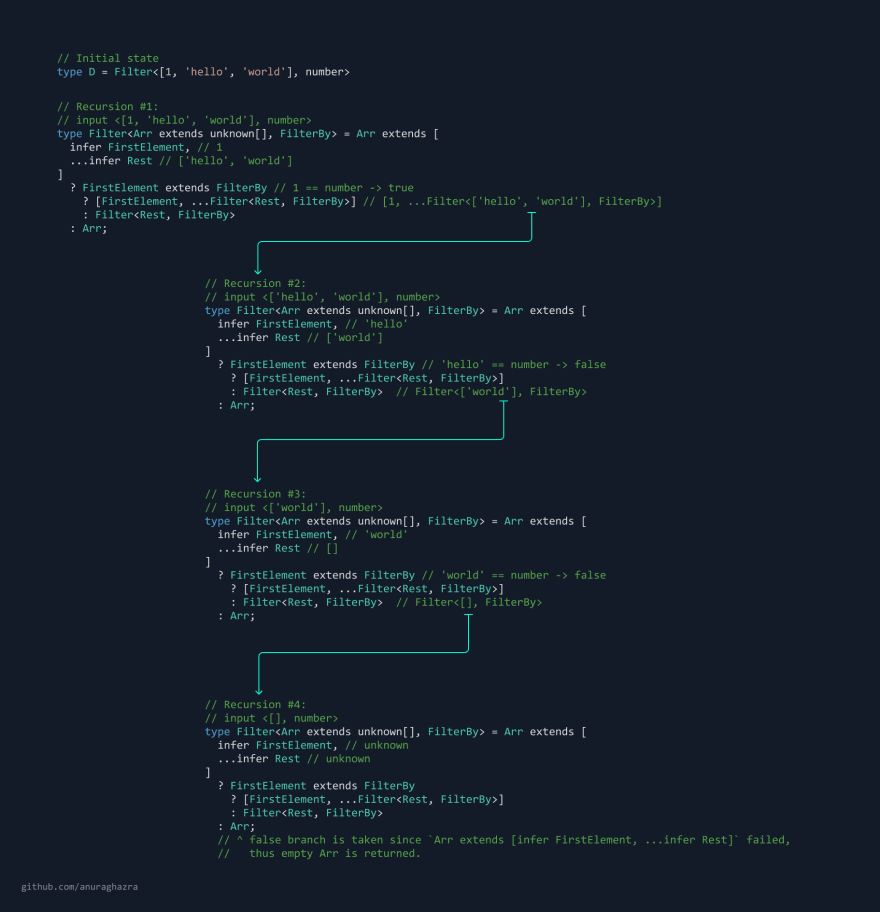An Interest In:
Web News this Week
- April 2, 2024
- April 1, 2024
- March 31, 2024
- March 30, 2024
- March 29, 2024
- March 28, 2024
- March 27, 2024
Byte sized TypeScript 1 - Filter type
Hiya! Welcome to the first post of my new TypeScript blogpost series.
In this series I'll demonstrate & deconstruct byte sized TypeScript snippets to help you understand how to write type-level code.
Let's start shall we?
Filter Type
In TypeScript we have a notion of tuple types which are basically directly comparable to Arrays in js. It looks something like this:
type MyTuple = [1, 2, string, boolean, null];Now let's say we want to implement a Filter method similar to JavaScript's native Array.Filter in Type Level, how do we do this?
Here's the full implementation:
As we go forward I'll explain this type line by line.
type Filter<Arr extends unknown[], FilterBy> = Arr extends [ infer FirstElement, ...infer Rest] ? FirstElement extends FilterBy ? [FirstElement, ...Filter<Rest, FilterBy>] : Filter<Rest, FilterBy> : Arr;type Demo = Filter<[1, 2, string, boolean], number>// -> [1, 2]Line 1:
In line 1 we have Arr extends [ infer FirstElement, ...infer Rest]
In here we are saying:
If Arr is equal to [infer FirstElement, ...infer Rest] then go into the true branch of the conditional type. This line will also ensure that the passed Arr is actually a Tuple. If not, the false branch will be taken which is returning the Arr in the last line.
The important part is the infer keyword, infer keyword is the inspection glass of TypeScript, it can extract what the value of the type is at a particular place.
Basically we are asking the TypeScript compiler "Hey! whatever is in this place assign it to this variable called FirstElement"
Then we can access this FirstElement type's value in the conditional branch.
Let's see an example:
type GetFirstElementOfArray<Arr extends any[]> = Arr extends [infer FirstElement, ...infer Rest] ? FirstElement : nevertype Demo = GetFirstElementOfArray<[1, 2, 3]> // 1You'll also notice the ...infer Rest part, It is similar to JavaScript's rest syntax. This part will infer the rest of the elements in the array and save it in the variable called Rest which you can also access in the conditional branch, in this case it will have the values [2, 3].
Line 5, 6, 7:
Now we are inside the true branch of the conditional type
At FirstElement extends FilterBy we are checking if the FirstElement is equal to FilterBy
If the above condition passes we are going to return a new tuple type [FirstElement, ...Filter<Rest, FilterBy>], here we are including the FirstElement & then recursively calling the Filter generic again with the Rest of the elements.
Notice that we are also using the spread syntax
...Filter<Rest, FilterBy>, since the Filter generic returns a tuple we can spread it's value in this new tuple we are returning.
And if FirstElement extends FilterBy fails we are going to call the Filter recursively again but skipping the FirstElement this time, Filter<Rest, FilterBy>.
Now let's step through the code on each recursive call to understand better what's happening:
// Initial statetype D = Filter<[1, 'hello', 'world'], number>Recursion #1:
// input <[1, 'hello', 'world'], number>type Filter<Arr extends unknown[], FilterBy> = Arr extends [ infer FirstElement, // 1 ...infer Rest // ['hello', 'world']] ? FirstElement extends FilterBy // 1 == number -> true ? [FirstElement, ...Filter<Rest, FilterBy>] // [1, ...Filter<['hello', 'world'], FilterBy>] : Filter<Rest, FilterBy> : Arr;Recursion #2:
// input <['hello', 'world'], number>type Filter<Arr extends unknown[], FilterBy> = Arr extends [ infer FirstElement, // 'hello' ...infer Rest // ['world']] ? FirstElement extends FilterBy // 'hello' == number -> false ? [FirstElement, ...Filter<Rest, FilterBy>] : Filter<Rest, FilterBy> // Filter<['world'], FilterBy> : Arr;Recursion #3:
// input <['world'], number>type Filter<Arr extends unknown[], FilterBy> = Arr extends [ infer FirstElement, // 'world' ...infer Rest // []] ? FirstElement extends FilterBy // 'world' == number -> false ? [FirstElement, ...Filter<Rest, FilterBy>] : Filter<Rest, FilterBy> // Filter<[], FilterBy> : Arr;Recursion #4:
// input <[], number>type Filter<Arr extends unknown[], FilterBy> = Arr extends [ infer FirstElement, // unknown ...infer Rest // unknown] ? FirstElement extends FilterBy ? [FirstElement, ...Filter<Rest, FilterBy>] : Filter<Rest, FilterBy> : Arr; // ^ false branch is taken since `Arr extends [infer FirstElement, ...infer Rest]` failed, // thus empty Arr is returned.That's about it, I hope you understood how the Filter type works now. At it's core the type is simple enough but understanding how each piece works is the important part.
In case you still couldn't understand the type level code, how about we rewrite the type level code to runtime javascript code?
You'll be surprised how similar it looks:
function Filter(Arr, FilterBy) { if (Arr.length < 1) return Arr; const [FirstElement, ...Rest] = Arr; if (typeof FirstElement === FilterBy) { return [FirstElement, ...Filter(Rest, FilterBy)]; } else { return Filter(Rest, FilterBy) }}Filter([1, 2, 3, 'hello', true], 'number')// [1, 2, 3]Cool isn't it?
Anyways I think that's about it, I hope you learned something new & enjoyed the post.
I'll be continuing this blogpost series, so make sure to follow me on twitter or dev.to to get updated.
Original Link: https://dev.to/anuraghazra/byte-sized-typescript-1-filter-type-3ga5
Dev To
 An online community for sharing and discovering great ideas, having debates, and making friends
An online community for sharing and discovering great ideas, having debates, and making friendsMore About this Source Visit Dev To



